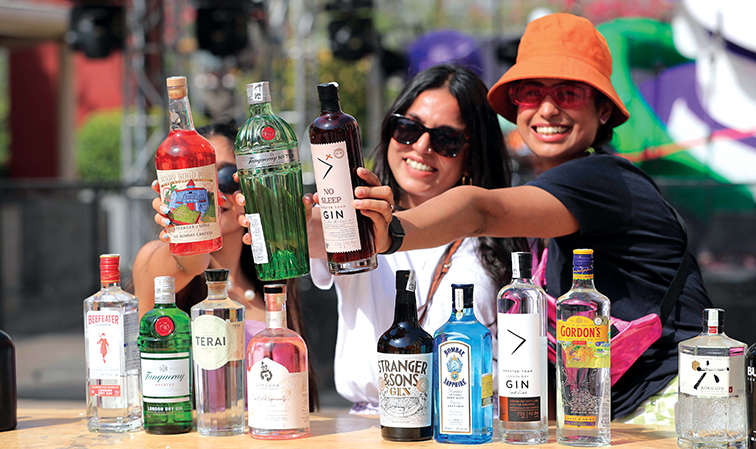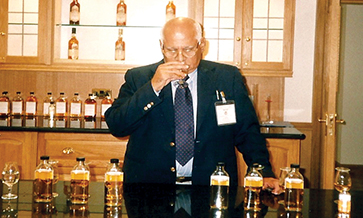With exotic botanicals and cross-border collaborations, Indian gin is helping redefine cocktails across markets
“Rumours of my death are greatly exaggerated” is a popular misquote attributed to Mark Twain; but the same stands true of premium gin in India. As agave makes a takeover bid at gunpoint, rum plots an upscale revival, and whisky goes craft, the gin tide has started to flow again with a strong momentum.
To put things in perspective, although its share of voice may be significant, gin still only accounts for 1% of India’s spirits market – “and even lower when we talk about premium spirits”, says Anand Virmani, Co-Founder of Nao Spirits.
On the other hand, Rachit Gupta at Campari India notes that IWSR data indicates that premium gin is expected to grow at 11.1% between 2020 and 2025.
Vikram Damodaran, Chief Innovation Officer at Diageo India, attributes it to “repertoire behaviour when it comes to spirits” wherein each spirit plays a certain role, not necessarily to the point of exclusion of the other.
With vodka in pole position, how did gin get to this point? And that too from a market dominated by compound gins like Blue Riband, and awash with gin myths?

Nao Spirits collaborated with Sleepy Owl Coffee to make No Sleep (L), a coffee-infused gin. Nao’s Anand Virmani says limited editions are fun and have kept the conversation around gin fresh and vibrant.
Twin evolution
While the presence of premium gin brands such as Hendrick’s, Tanqueray and Bombay Sapphire did help, the clear transition one can make is when Greater Than (from Nao Spirits) opened the floodgates. This marked a twin evolution for gin in India, as well as for Indian quality and craft spirits.
With the coming of brands like Greater Than, Stranger and Sons, and Hapusa – who combined quality of liquid with contemporary branding values – it suddenly made “cool” the consumption of Indian spirits.
Sakshi Saigal, Co-Founder of Third Eye Distilleries says, “Indian gins are helping change the global narrative of Indian spirits.”
It definitely helped that travel had already eased the path for consumers to discover gin overseas, and that bartenders were drawn to it for the flavourful possibilities it offered in their cocktail menus.
Anand (of Nao) says, “Bars and the people behind these bars care about the quality of what they are serving, not just the higher margin they stand to make on a cheaper product”.
The breakneck success enjoyed by Greater Than and Stranger and Sons laid the foundations of premium gin in India, with their combined recent volumes believed to be well in excess of a lakh cases. Before you can say ‘juniper’, we already have Indian gin brands well into the double digits!
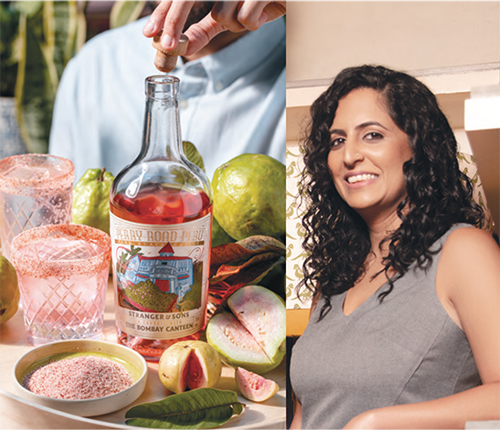
Third Eye Distilleries’ Perry Road Peru distilled cocktail (L) was a runaway hit. Co-Founder Sakshi Saigal (R) promises to launch a unique distilled cocktail each year.
Think small
A contributor to the ‘Ginaissance’ has been an asset-light strategy, provided by states like Goa. Brands have either been able to piggyback on existing facilities such as Blue Ocean Beverages and Fullarton Distilleries, or set up their stills there (Nao Spirits and Third Eye Distillery respectively).
Jin Jiji (an export only gin, available in two variants, including an excellent Darjeeling tea version) had its recipe developed by Nao Spirits. So is the case with other start-up gins such as Goa’s Matinee.
Needless to say, it lowers barriers of entry considerably; but as brand owners have realised, they also need a Plan B in the event of falling out with partners, or safety conditions on the bottling premises.
Karina Agarwal, Vice-President of Indian Craft Spirits Co., makers of Terai gin, casts a perceptive eye on the ‘Ginaissance’. “Gin’s beauty is its versatility,” she says, “People can choose how they like to drink it.”
Karina notes: “There’s no reason also for bars or bartenders to turn away from gin, as happened with vodka due to this same versatility. There has been an explosion in digital media, and gin is the clear favourite when it comes to doing it yourself.”
The lockdown, I’m sure, has played no small role in this, with most kits from bars geared towards easy mixing with gin, and consumers helping themselves by turning bartenders.
More importantly for Karina, “Gin from India is no longer being viewed through the lens of the exotic. As more brands go on the world stage, the narrative has shifted to the branding and packaging, the botanicals, collaborations, and ultimately the liquid itself.”
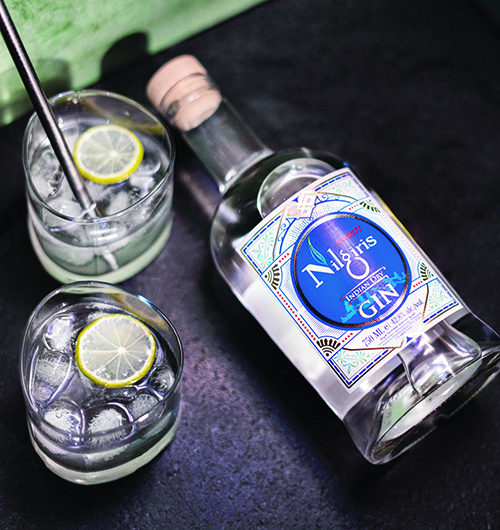
Gin is being manufactured away from Goa too: Amrut Distilleries makes Nilgiris dry gin in Bengaluru; Terai gin comes from Globus Spirits in Behror; and Jaisalmer gin takes birth in Rampur.
Global markets
Indian gins have drawn critical acclaim as well. Nao’s Hapusa picked up gold and double-gold at prestigious awards such as the IWSC and ISC; and Greater Than bagged a double gold at the SF World Spirits Championship.
Nao Spirits was also shortlisted last year by the IWSC as one of the top five international gin producers in the world. Stranger and Sons has also been no slouch in the awards department, picking up multiple gold medals at major international spirits showings, leading to 70,000 bottles being shipped to homes across the UK.
Gin is being democratised too, in more ways than one. It is no longer the preserve of first-time entrepreneurs, but spreading to India’s mid-sized alcobev companies, and away from Goa too.
Amrut Distilleries makes its Nilgiris dry gin in Bengaluru; Terai gin comes from Globus Spirits in Behror (Rajasthan); and Jaisalmer gin takes birth at Radico Khaitan’s distillery in Rampur (Uttar Pradesh).
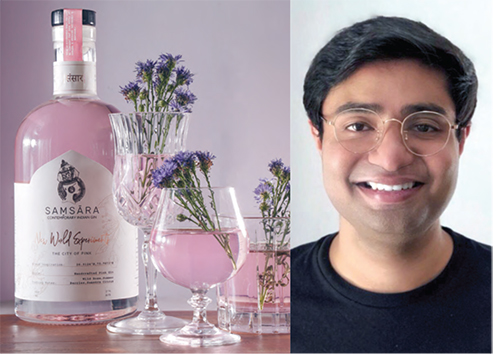
Goa’s Samsara gin (L) was India’s first indigenous pink gin. Its Founder, Aditya Agarwal (R), assigns a key role to gin in ushering a cocktail culture to the market.
Liquid intelligence
Indian gins have a powerful weapon in their armoury as they take on the world: botanicals. Says Anand (Nao): “India is at the heart of the world spice trade. Gin is the one spirit made with spices at the heart of it – ignore spiced rum for a moment.”
Karina (Samsara) adds: “Gin gives the opportunity for your product to take risks. Either love it or hate it.” She sees untapped potential in botanicals from the North-East, as also in spices from South India.
The use of Indian botanicals has been well documented, from Jin Jiji’s Darjeeling tea to Stranger and Sons with Gondhoraj and Tickle gin’s raw mango.
Goa’s Tamras makes five separate distillates for its gin that, after mixing together, go through a 28-day slow dilution process, with water drip-fed every alternate day.
Solomon Diniz, Founder of Adinco Distilleries in Goa, says that for Tickle gin, he uses a “cold-press process for the extraction of botanicals, without having to heat them”. That helps in extracting maximum flavour from mangoes.
The grain source is becoming another point of differentiation for brands, with traditional bases of wheat now slowly giving way, in part or wholly, to other grains like rice (Tamras gin).

Karina Agarwal (L), Vice-President of Indian Craft Spirits Co., praises gin’s versatility. “People can choose how they like to drink it.” Ruchika Gupta (R), Marketing Director at Beam Suntory India, says that with the launch of Sipsmith, the company is planning installation of ‘Swanzones’.
Innovation next
In a definite sign of the maturing of the Indian craft gin sector, one has seen a wave of innovations. Greater Than launched its Juniper Bomb – an accident, or so the story goes, when three times the regular amount of juniper berries landed in the still!
Another one is No Sleep, a coffee-infused gin, made in collaboration with Sleepy Owl Coffee. “Limited editions have been really fun and have played a vital role in keeping the conversation around Greater Than fresh and vibrant,” says Nao’s Anand.
Stranger and Sons was off the block early with Perry Road Peru, a distilled cocktail made in collaboration with The Bombay Canteen, and a runaway hit. Now the brand promises to “launch a unique distilled cocktail each year”.
Third Eye Distillery has also collaborated with one of the world’s critically acclaimed gin makers, Australia’s Four Pillars Distilleries. Two gins, Spice Trade (made in Australia using Indian botanicals) and Trading Tides (a “coastal” dry gin using unique botanicals from Australia) are slated for release in India this summer.
Goa’s Samsara gin, realising that the Indian palate likes it sweeter, launched India’s first indigenous pink gin, with notes of rose and strawberry. More recently, Goa’s Fullarton Distilleries has introduced Pumori Ascent, “India’s first aged gin”.
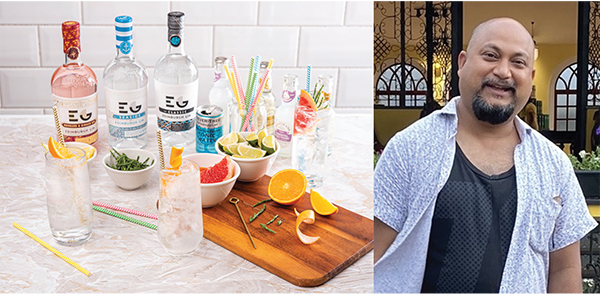
After launching Edinburgh gin (L), Aneesh Talukdar, General Manager of Ian Mcleod (R), says his company is also taking on spritz and gin liqueurs with sparkling wine.
Gin-in-a-can
We now have the first indigenous ready-to-drink offerings in the form of a range of G&Ts, from Salud Beverages (Bengaluru) to other canned products, including Bombay Sapphire.
The proliferation of G&T brands, both Indian and imported, is clearly on the back of the gin boom. Apart from making daytime drinking easy and acceptable, it has made mixing up simple but flavourful drinks far more accessible at home. Among those tapping into this niche market are the Gin Cherry Sour from Greater Than and Jimmy’s Cocktails, among others.
Brands like Stranger and Sons have tapped into this with the launch of ‘Two Tailed Tipples’, bottled cocktails introduced in conjunction with bars across India, such as Goa’s Hideaway and Mumbai’s Cin Cin.
Curating experiences
Gin brands, both Indian and imported, are quick to point out the importance the enabling ecosystem has played in the growth of gin. No small contributor to this has been the countless bar takeovers, sundowners, pop-ups and cocktail menus, all powered by gin brands.
“On Trade is providing more curated experiences for consumers, giving us the chance to creatively engage with them,” says Adtnu Tiwari of Bombay Sapphire.
Samsara’s Aditya Agarwal says, “Gin has been the key player in bringing a cocktail culture to the market.” I’m sure Indian bars also have a debt to gin.
From gin cocktails to gin menus to gin bars are but short steps. The first, of course, was Juniper at Delhi’s Andaz, which boasted a range of “home-infused” gins; followed by Jyran at Mumbai’s Sofitel; and more recently by Sylvia at the W in Goa.
The next biggest factor acknowledged by the industry is the advent of large direct-to-consumer events such as the India Cocktail Week and Gin Explorer’s Club (GEC), with editions of these spreading across India, and drawing up to tens of thousands of consumers over a weekend.
Of the GEC’s recent Delhi edition, Co-Founders Anjali Batra and Shuchir Suri said: “The feeling was surreal to be reunited with gin lovers across Delhi after 2 years. It was an epic weekend of ginning. We cannot wait to take this festival to other cities.”

Monika Enterprise Founder Kunal Patel (R) sees potential in styles such as Hayman’s range (L) of Old Tom, Small Gin, Exotic Citrus or Peach-n-Rose.
Flavours, colours
Multi-national alcobev companies are well aware of the momentum that has built up in favour of Indian gin brands and are staking out different territories. They are bringing in, or planning to bring in, their premium and super-premium offerings: Diageo’s Aviation and Chase gins, Pernod’s Kinobi, a Kyoto dry gin, Campari with Bulldog, and Beam Suntory with Sipsmith.
Ruchika Gupta, Marketing Director at Beam Suntory India says, “With the launch of Sipsmith, we are also looking at the installation of ‘Swanzones’, a dedicated space for On-Trade accounts delivering a comprehensive brand experience in select locations.”
Flavours and colours are other considerations for differentiation and market reach. Pernod’s Beefeater Pink gin is already here; and a range of Malfy gins is expected soon.
Ian Mcleod (Edinburgh gin) has launched flavours such as rhubarb, ginger, gooseberry and elderflower, as well as its London Hill pink gin. Aneesh Talukdar, General Manager of the company, says Ian Mcleod is also taking on spritz by offering consumers the option of gin liqueurs (raspberry, apple and spice) with sparkling wine.
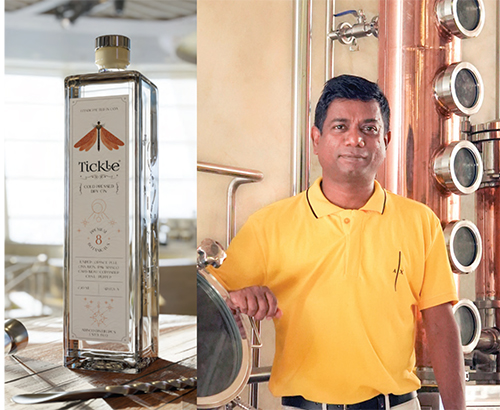
Solomon Diniz (R), Founder of Adinco Distilleries in Goa, says that for Tickle gin (L), he uses a cold-press process for the extraction of flavour from mangoes.
Newer geographies
Hendrick’s super-premium gin was perhaps the first to stir the pot in the Indian gin market with Midsummer Solstice. It is following up with the second release from its Cabinet of Curiosities, the Hendrick’s Lunar Gin.
Monika Enterprise sees potential in styles like Old Tom. “With so many gins in the space right now, consumers have a lot of choices to try out; but a majority of these are London Dry,” says its Founder, Kunal Patel.
“This is where I believe the Langley’s Old Tom and Hayman’s range of Old Tom, Small gin, Exotic Citrus or Peach-n-Rose are going to make their own place in the growing gin category,” he adds.
Of course, there’s always the option of taking a slice of an Indian gin company. Diageo India recently acquired a stake in Nao Spirits (Greater Than and Hapusa). “We believe the role of Diageo in India is to foster and nurture the fledgling spirits start-up ecosystem”, says Vikram.
“Empires have been built on the basis of our produce. Creating gins that dominate the world should be rather easier in comparison,” says Aman Thadani of Fullarton Distilleries. Prophecy or hubris? I think the former – and here’s hoping that the next few years bear all the voices we’ve heard right.
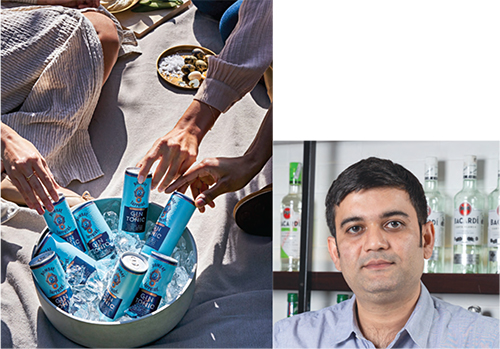
Adtnu Tiwari (R) of Bombay Sapphire (L) says gin makers must offer curated experiences for consumers.










